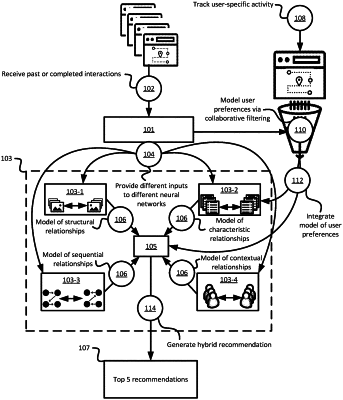| CPC G06N 3/045 (2023.01) [G06F 17/16 (2013.01); G06N 3/044 (2023.01); G06N 3/047 (2023.01); G06N 3/08 (2013.01)] | 20 Claims |

|
1. A device, comprising:
one or more processors configured to:
model, within a first neural network, a first set of relationships between a plurality of different users and one or more items based on a plurality of interactions by the plurality of users, wherein modeling the first set of relationships comprises generating a first matrix with a first set of normalized values representing the first set of relationships;
model a second set of relationships from the plurality of interactions within a second neural network, wherein the first set of relationships comprises a first set of characteristic or structural data associated with the plurality of interactions, and wherein the second set of relationships comprises a second set of characteristic, contextual, or sequential data associated with the plurality of interactions, wherein modeling the second set of relationships comprises generating a second matrix with a second set of normalized values representing the second set of relationships;
track activities by one or more users of the plurality of users;
generate a personalized model via collaborative filtering of the activities by the one or more users;
integrate the personalized model into the modeling of the first set of relationships;
generate a recommendation matrix with a plurality of vectors that rank a plurality of candidate items based on combined sets of probability values resulting from integrating the personalized model into the modeling of the first set of relationships, wherein generating the recommendation matrix comprises concatenating the first matrix, the second matrix, and a matrix derived from the personalized model; and
modify a user interface (“UI”) to present one or more of the plurality of candidate items based on one or more of the plurality of vectors that rank the one or more candidate items higher than other items from the plurality of candidate items.
|